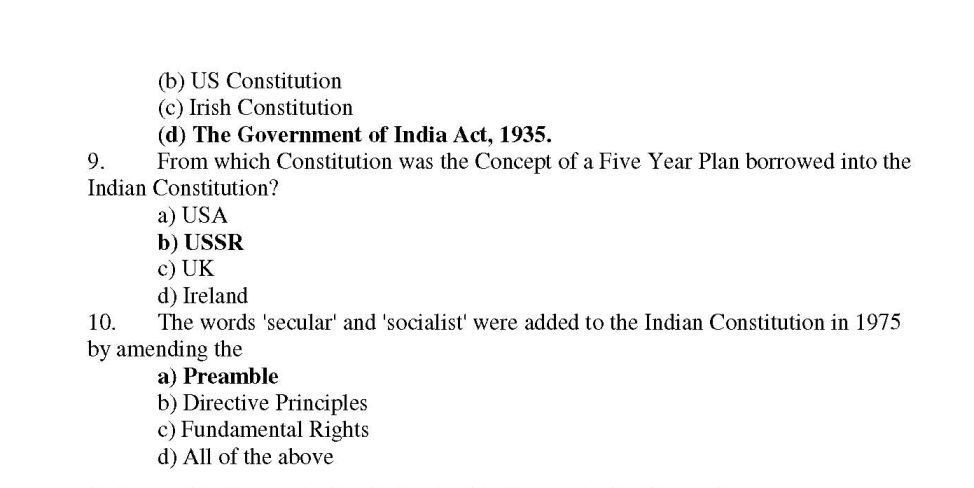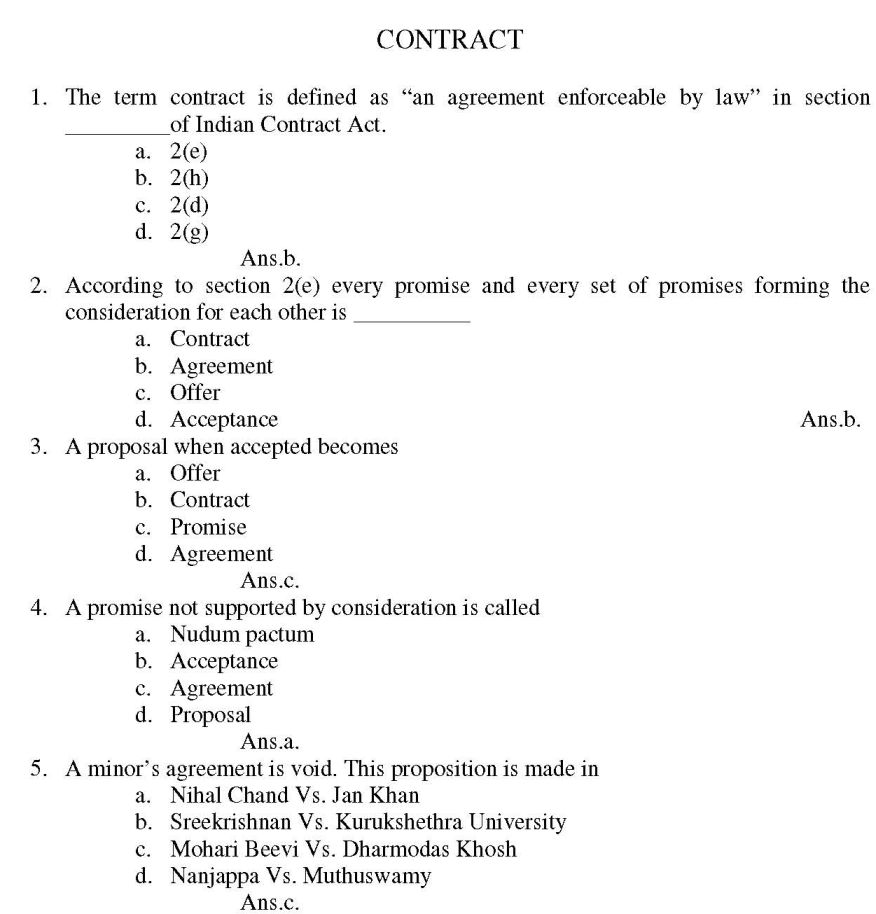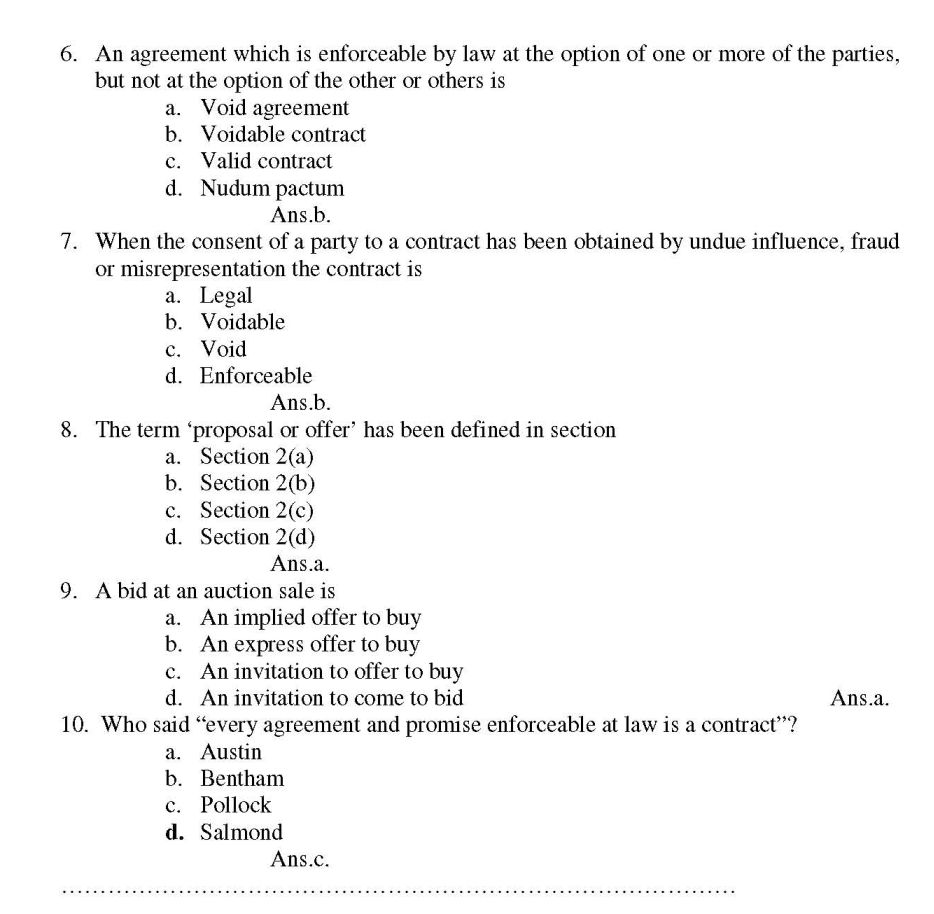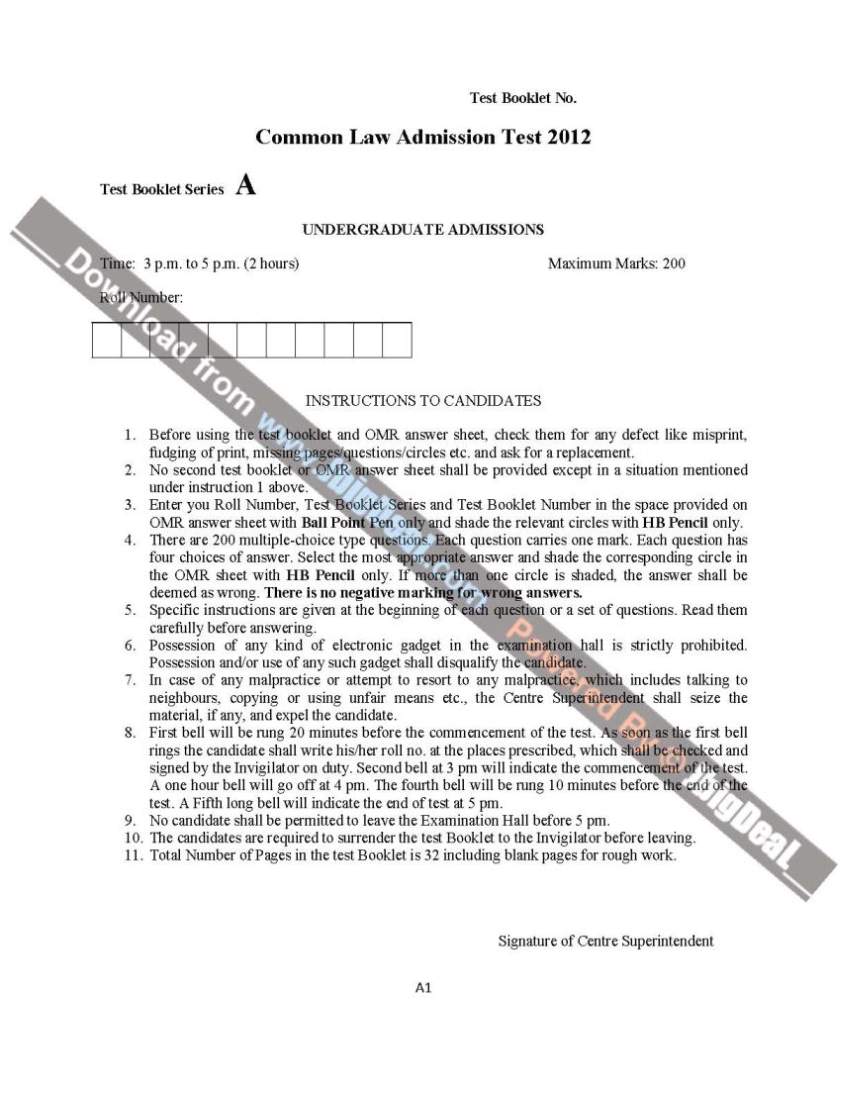| Re: CLAT Exam Question Paper
Here is the list of few questions of CLAT Exam Question Paper which you are looking for .
Instructions (1 to 10): Read the given passage carefully and attempt the questions that follow.
The work which Gandhiji had taken up was not only regarding the achievement of political
freedom but also the establishment of a new social order based on truth and non-violence, unity
and peace, equality and universal brotherhood and maximum freedom for all. This unfinished
part of his experiment was perhaps even more difficult to achieve than the achievement of
political freedom. In the political struggle, the fight was against a foreign power and all one
could do was either join it or wish it success and give it his/her moral support. In establishing a
social order on this pattern, there was a strong possibility of a conflict arising between diverse
groups and classes of our own people. Experience shows that man values his possessions even
more than his life because in the former he sees the means for perpetuation and survival of his
descendants even after his body is reduced to ashes. A new order cannot be established without
radically changing the mind and attitude of men towards property and, at some stage or the other,
the 'haves' have to yield place to the 'have-nots'. We have seen, in our time, attempts to achieve a
kind of egalitarian society and the picture of it after it was achieved. But this was done, by and
large, through the use of physical force.
In the ultimate analysis it is difficult, if not impossible, to say that the instinct to possess has been
rooted out or that it will not reappear in an even worse form under a different guise. It may even
be that, like a gas kept confined within containers under great pressure, or water held back by a
big dam, once the barrier breaks, the reaction will one day sweep back with a violence equal in
extent and intensity to what was used to establish and maintain the outward egalitarian form.
This enforced egalitarianism contains, in its bosom, the seed of its own destruction.
The root cause of class conflict is possessiveness or the acquisitive instinct. So long as the ideal
that is to be achieved is one of securing the maximum material satisfaction, possessiveness is
neither suppressed nor eliminated but grows on what it feeds. Nor does it cease to be
possessiveness, whether it is confined to only a few or is shared by many.
If egalitarianism is to endure, it has to be based not on the possession of the maximum material
goods by a few or by all but on voluntary, enlightened renunciation of those goods which cannot
be shared by others or can be enjoyed only at the expense of others. This calls for substitution of
material values by purely spiritual ones. The paradise of material satisfaction, which is
sometimes equated with progress these days, neither spells peace nor progress. Mahatma Gandhi
has shown us how the acquisitive instinct inherent in man can be transmuted by the adoption of
the ideal of trusteeship by those who 'have' for the benefit of all those who 'have not' so that,
instead of leading to exploitation and conflict, it would become a means and incentive for the
amelioration and progress of society respectively.
1. According to the passage, egalitarianism will not survive if
(A) It is based on voluntary renunciation
(B) It is achieved by resorting to physical force
(C) Underprivileged people are not involved in its establishment.
(D) People's outlook towards it is not radically changed.
2. According to the passage, why does man value his possessions more than his life?
(A) He has inherent desire to share his possession with others.
(B) He is endowed with the possessive instinct.
(C) Only his possession helps him earn love and respect from his descendants.
(D) Through his possessions he can preserve his name even after his death.
3. According to the passage, which was the unfinished part of Gandhi's experiment?
(A) Educating people to avoid class conflict.
(B) Achieving total political freedom for the country
(C) Establishment of an egalitarian society
(D) Radically changing the mind and attitude of men towards truth and non-violence.
4. Which of the following statements is 'not true' in the context of the passage?
(A) True egalitarianism can be achieved by giving up one's possessions under
compulsion.
(B) Man values his life more than his possessions.
(C) Possessive instinct is a natural desire of human beings
(D) In the political struggle, the fight was against alien rule.
5. According to the passage, true egalitarianism will last only if
(A) It is thrust upon people.
(B) It is based on truth and non-violence.
(C) People inculcate spiritual values instead of material values.
(D) 'Haves' and 'have-nots' live together peacefully
6. According to the passage, people ultimately overturn a social order -------
(A) which is based on coercion and oppression.
(B) which does not satisfy their basic needs
(C) which is based upon conciliation and rapprochement.
(D) which is not congenital to the spiritual values of the people
7. According to the passage, the root cause of class conflict is
(A) The paradise of material satisfaction.
(B) Dominant inherent acquisitive instinct in man.
(C) Exploitation of the 'have-nots' by the 'haves'.
(D) A Social order where the unprivileged are not a part of the establishment.
8. Which of the following statements is 'not true' in the context of the passage?
(A) A new order can be established by radically changing the outlook of people
towards it.
(B) Adoption of the ideal of trusteeship can minimize possessive instinct.
(C) Enforced egalitarianism can be the cause of its own destruction
(D) Ideal of new order is to secure maximum material satisfaction
9. Which of the following conclusions can be deduced from the passage?
(A) A social order based on truth and non-violence alone can help the achievement of
political freedom.
(B) After establishing the social order of Gandhiji's pattern, the possibility of a conflict
between different classes of society will hardly exist.
(C) It is difficult to change the mind and attitude of men towards property.
(D) In an egalitarian society, material satisfaction can be enjoyed only at the expense
of others.
10. According to the passage, what does "adoption of the ideal of trusteeship" mean?
(A) Equating peace and progress with material satisfaction.
(B) Adoption of the ideal by the 'haves' for the benefit of ‘have-nots’.
A5
(C) Voluntary enlightened remuneration of the possessive instinct by the privileged
class.
(D) Substitution of spiritual values by material ones by those who live in the paradise
of material satisfaction.
Instructions (11 to 15): Choose the correct synonym out of the four choices given.
11. Lethargy
(A) Serenity (B) listlessness (C) impassivity (D) laxity
12. Emaciated
(A) tall (B) languid (C) very thin (D) wise
13. Latent
(A) concealed (B) apparent (C) lethargic (D) prompt
14. Sporadic
(A) epidemic (B) whirling (C) occasional (D) stagnant
15. Compendium
(A) summary (B) index (C) reference (D) collection
Instructions (16 to 25): Choose the correct option out of the four choices given.
16. Give an example pertinent ______________ the case.
(A) with (B) on (C) for (D) to
17. My voice reverberated _____________ the walls of the castle.
(A) with (B) from (C) in (D) on
18. The reward was not commensurate _________ the work done by us.
(A) for (B) on (C) with (D) order
19. Our tragic experience in the recent past provides an index _______ the state of lawlessness
in this region.
(A) of (B) in (C) at (D) by
20. Your conduct smacks ___________recklessness.
(A) of (B) with (C) from (D) in
21. A good judge never gropes ____________the conclusion.
(A) to (B) at (C) on (D) for
22. Nobody in our group is a genius _________winning friends and in convincing people.
(A) for (B) in (C) of (D) at
23. If you are averse _________recommending my name, you should not hesitate to admit it.
(A) about (B) for (C) to (D) against
24. Religious leaders should not delve ________ politics.
(A) in (B) with (C) at (D) into
25. What you say has hardly any bearing ________ the lives of tribals.
(A) about (B) for (C) on (D) with
Instruction (26 to 30): Select the correct meaning of the italicized idioms and phrases out of the
four choices given.
26. He burnt his fingers by interfering in his neighbor’s affair.
(A) got himself into trouble (B) burnt himself
(C) got himself insulted (D) got rebuked
27. Mr. Gupta, who is one of the trustees of a big charity, is suspected of feathering his own
nest.
(A) being lazy in doing his work (B) being too generous
(C) neglecting his job (D) making money unfairly
28. Mrs. Hashmi has been in the blues for the last several weeks.
(A) abroad (B) unwell (C) depressed (D) penniless
29. For the first week, the apprentice felt like a fish out of water.
(A) frustrated (B) homeless (C) disappointed (D) uncomfortable
30. His friends failed to see why he should ride the high horse just because he had won an
election.
(A) become abnormal (B) appear arrogant
(C) indulge in dreams (D) hate others
Instructions (31 to 35): Given below are the jumbled sentences of a paragraph. The first and
the last sentence of the jumbled paragraph are given in correct order. Arrange the middle
sentences in the correct sequence.
31.
i. On one hand we are proud of being Indians,
ii. on the other hand we behave as if we were still at the dawn of our civilization
iii. murders of our own brothers and sisters is not the way to please Ram or Rahim
iv. the citizens of the land where Buddha and Gandhi taught
v. the principles of love and non-violence,
vi. nor does it fetch us any prosperity.
(A) ii, iii, iv, v (B) iii, iv, v, ii
(C) iv, v, iii, ii (D) iv, v, ii, iii
32.
i. On the basis of experiments with rats
ii. health experts here say that
iii. exercise more and consume vitamins,
iv. they will live up to 100 years or more
v. if humans eat less,
vi. and be vigorous in their eighties and nineties.
(A) ii, iii, v, iv (B) ii, v, iii, iv
(C) ii, v, iv, iii (D) v, ii, iii, iv
33.
i. The release of atomic energy is the greatest achievement which science has yet attained
ii. but the first invention to which their discoveries were applied was a bomb
iii. the atom was split by physicists whose minds were set on the search for knowledge
iv. it was more deadly than any other weapon invented so far
v. it is with dread that scientists regard the first use to which their greatest discovery was put
vi. however, they are gratified by the numerous applications of atomic energy for peaceful
and constructive population.
(A) ii, iii, iv, v (B) v, iii, ii, iv
(C) iii, ii, iv, v (D) iv, v, iii, ii
34.
i. The problem of food is intimately connected with population
A7
ii. wages will seldom rise in proportion to the rising prices
iii. the market is governed by demand and supply
iv. without enough food, such people lack health, strength of efficiency
v. if too many people demand goods to go round, prices will rise and poor classes will
starve
vi. they fall an easy prey to all sorts of diseases.
(A) iii, v, ii, iv (B) ii, iii, iv, v
(C) iv, ii, v, iii (D) v, iii, iv, ii
35.
i. India's message has always been one of love and peace.
ii. our Buddha was the light of Asia
iii. it has been a source of light and wisdom to the rest of the world
iv. Ashoka, moved by the horrors of Kalinga War, adopted the message of non-violence
v. the greatest apostle of non-violence in recent years was Mahatma Gandhi
vi. he shook the foundation of the British rule in India through non-violence.
(A) ii, v, iii, iv (B) iv, ii, iii, v
(C) v, iv, iii, ii (D) iii, ii, iv, v
Instructions (36 to 40): Given below are a few commonly used foreign language phrases, select
the correct answer from the four options given below.
36. Mala fide
(A) generous (B) bad intention
(C) trustworthy (D) genuine
37. Tabula rasa
(A) clean slate (B) agitated
(C) deprived (D) creative
38. Carte blanche
(A) slavery (B) complete discretion
(C) anarchy (D) dependent
39. De jure
(A) illegal (B) heir
(C) concerning law (D) forbidden
40. Raison d’etre
(A) logical conclusion (B) reason for existence
(C) free choice (D) dubious argument
GENERAL KNOWLEDGE/CURRENT AFFAIRS
41. Who said that, ‘Man is a social animal’?
(A) Socrates (B) Aristotle (C) Kahn (D)Plato
42. World Computer Literacy day is celebrated on
(A) November 14 (B) November 3 (C) December 2 (D) July 5
43. Whose teaching inspired the French Revolution?
(A) Rousseau (B) Locke (C) Hegel (D) Wagner
44. The II Africa-India Summit was held in May 2011 in
(A) New Delhi (B)Lagos (C)Nairobi (D) Addis Ababa
45. The famous Akshardham temple is situated in the city of
(A) Jamnagar (B) Gandhinagar (C)Jammu (D) Madurai
46. Who out of the following was the recipient of Dhyan Chand Award in 2011?
(A) Satish Pillai (B) Hukam Singh (C)Shabbir Ali (D) Mukh Bain Singh
47. Name the annual fair of Rajasthan that is famous for its camel trading event.
(A) Maru Mela (B) Pushkar Mela (C)Suraj Kund Mela (D) Sonepur Mela
48. The 38th G-8 summit will be held in 2012 in
(A) USA (B)UK (C) Germany (D) Canada
49. Who was awarded the Nobel Prize for literature in 2011?
(A) Paul Lauterbur (B) Bill Clinton (C) Tomas Transtromer (D) Shirin Ebadi
50. Who was awarded the UNESCO King Sejong Literacy Prize in 2011?
(A) Nelson Mandela (B) National Literacy Service, Burundi
(C) Medha Patkar (D) National Literacy Mission, India
51. December 10 is observed as
(A) World Health Day (B) U. N. Day
(C) Red Cross Day (D) Human Rights Day
52. Which is the largest gland in human body?
(A) Pancreas (B) Liver (C) Thyroid (D)Pituitary
53. The book titled ‘The Google Story’ has been authored by
(A) David A. Vice (B) Shobha Dey (C) Fredrick Forsyth (D)Vikram Seth
54. Which strait separates Europe from Africa
(A) Mallaica (B) Gibralter (C) Berring (D) Palk
55. Taiwan was earlier known as
(A) Fuchow (B)Marshall Island (C)Formosa (D) Macau
56. Identify the Indian Tennis player who has turned Hollywood filmmaker?
(A) Vijay Amritraj (B) Mahesh Bhupathi
(C) Leander Paes (D) Ashok Amritraj
57. Where will the next Olympic Games be held in 2012?
(A) Tokyo (B)Berlin (C) London (D)Toronto
58. Which of the following teams has won the Santosh Trophy Football Championship in 2011?
(A) Punjab (B)West Bengal (C) Goa (D) Railways
A9
59. Excess of money supply as compared to supply of goods results in
(A) Depression (B) Deflation (C) Trade deficit (D)Inflation
60. The largest living flightless bird is
(A) Emu (B)Kiwi (C)Ostrich (D)Penguin
61. Which of the following oceans has the shape of the English letter ‘S’?
(A) Atlantic (B)Pacific (C)Indian (D)Arctic
62. Which is the longest shipping canal in the world?
(A) Panama Canal (B) Suez Canal
(C) White Sea-Baltic Canal (D)Kiel Canal
63. Le Corbusier, the architect of Chandigarh was a national of
(A) Britain (B)Portugal (C)France (D)Netherlands
64. India became a member of UNO in
(A) 1945 (B)1947 (C)1950 (D) 1952
65. To which country does India export the largest quantity of iron ore?
(A) USA (B)Japan (C) Egypt (D) Germany
66. The longest highway in India runs from
(A) Kolkata to Jammu (B) Shillong to Amritsar
(C) Ambala to Nagercoil (D) Varanasi to Kanyakumari
67. The longest irrigation canal in India is called
(A) Upper Bari Doab Canal (B) Indira Gandhi Canal
(C) Sirhind Canal (D)Yamuna Canal
68. Leukemia is a disease related to
(A) Kidney (B)Throat (C) Blood (D)Eyes
69. In which city was Osama Bin Laden killed in May 2011?
(A) Islamabad (B) Abbottabad (C)Faisalabad (D)Peshawar
70. The XI Five Year Plan envisaged the highest growth in the sector of
(A) Industry (B) Agriculture (C) Services (D)Manufacturing
71. Light year is a unit of
(A) Distance (B) Time (C) Sound (D) Light intensity
72. The IV summit of BRICS was held in New Delhi on
(A) 11th January 2012 (B)1st April 2012
(C) 29th March 2012 (D)28th February 2012
73. An indigenous nuclear submarine still under construction has been named as
(A) Chakra (B) Sudarshan (C) Arihant (D) Ghaatak
74. Government of India has launched a publicity campaign for census 2011 in association with
which of the following UN organization?
(A) United Nations Development Programme (UNDP)
(B) World Health Organization (WHO)
(C) United Nations Children’s Fund (UNICEF)
(D) United Nations Population Fund (UNPF)
A10
75. Mahatma Gandhi National Rural Employment Guarantee Act (MGNREGA) completed how
many years of operation in 2011?
(A) 3 years (B) 4 years (C) 5 years (D) 6 years
76. The first ever formula one race in India was held in
(A) Greater Noida (B) New Delhi (C) Faridabad (D) Pune
77. Name the actor who has been honoured with the Dadasaheb Phalke Award in 2012.
(A) Naseerudin Shah (B) Kamal Hasan
(C) Soumitra Chatterjee (D) Amol Paleker
78. In which city was the Arab Summit held in the last week of March 2012?
(A) Bagdad (B) Cairo (C) Beirut (D) Riyadh
79. The two Supreme Court Judges who delivered the famous 2-G judgment in February 2012
were
(A) Justice G.S. Singhvi and Justice Gyan Sudha Mishra
(B) Justice G.S. Singhvi and Justice A.K. Ganguly
(C) Justice S.H. Kapadia and Justice A.K. Ganguly
(D) Justice Chandramauli Kumar Prasad and Justice H.L. Gokhale
80. Who presides over the joint sitting of both houses of Parliament?
(A) Speaker of Lok Sabha (B)President
(C) Chairman of Rajya Sabha (D)Prime Minister
81. Christian Lagarde heads the
(A) World Bank (B) UNICEF (C )International Monetary Fund (D)WHO
82. The seat of International Criminal Court is at
(A) The Hague (B)Geneva (C) Washington (D) Tokyo
83. First Indian to ski to North Pole is
(A) Arun Nayyar (B) Ajeet Bajaj (C)Sq. Ldr. Sanjay Thapar (D)Neal Paramjeet
84. First woman Director General of Police in India was
(A) Kanchan Choudhary (B) Kavitha Choudhary
(C) Kiran Bedi (D)Aswathy Tonge
85. Which countries co-hosted the One-day cricket World Cup in 2011?
(A) India, Bangladesh and Sri Lanka
(B) India, Bangladesh and Pakistan
(C) India, Sri Lanka and Pakistan
(D) India, Sri Lanka, Bangladesh and Pakistan
86. Priyanka Chopra has been named National Ambassador of
(A) WHO (B) UNICEF (C)UNESCO (D)International Red Cross Society
87. Who is leading in the Republican primaries to contest the American Presidential election
scheduled in November 2012?
(A) Sara Palin (B) Newt Gingrich (C) Rick Santorum (D) Mitt Romney
88. Supreme Court recently declared ‘Salva Judum’ unconstitutional. What is ‘Salva Judam’?
(A) A terrorist outfit
(B) An armed civilian group formed to combat Maoists
A11
(C) A money-chain business
(D) Custom of killing a girl for inter-caste marriage in the name of honour
89. As per the Indian Union Budget of 2012-13, the income-tax exemption limit for persons
below 65 years of age is
(A) Rs. 175000 (B) Rs. 200000 (C) Rs. 250000 (D) Rs.190000
90. The U. N. Climate Change Conference 2011 was held in
(A) New Delhi (B) Doha (C)Durban (D)Geneva
ELEMENTARY MATHEMATICS (NUMERIC ABILITY)
91. P sells a table to Q at a profit of 10% and Q sells it to R at a profit of 12%. If R pays Rs.
246.40 for it, then how much had P paid for it?
(A) 200.00 (B) 300.00 (C) 248.00 (D) 346.00
92. The least value of x, for which the expression x2+x+17 will not give a prime number, is
(A) 7 (B) 11 (C)13 (D)17
93. A train 300 meters long is running at a speed of 25 meters per second, it will cross a bridge
200 meters long in
(A) 5 seconds (B) 10 seconds (C) 20 seconds (D)25 seconds
94. If 0.06% of a number is 84, then 30% of that number is
(A) 25.2 (B) 420 (C) 42000 (D)2520
95. A sum was divided among P, Q & R. R got double than P who got double than Q. If the
difference between the shares of Q and R is Rs. 3675.00, then the sum in rupees is
(A) 4900 (B) 8575 (C)11025 (D) 7350
96. If the ratio of the areas of two squares is 25:36, then the ratio of their perimeters is
(A) 5:6 (B) 25:36 (C) 6:5 (D) 36:25
97. The denominator of a fraction is greater than its numerator by 11. If 8 is added to both its
numerator and denominator, then it becomes ¾. The fraction is
(A) 25/26 (B) 35/26 (C) 26/35 (D)25/36
98. The value of , where x= 2 +√3 and y = 2 - √3, is
(A) 12 (B)16 (C)14 (D)10
99. If the volume of a sphere is divided by its surface area, we obtain 27 cm. The radius of the
sphere is
A12
(A) 9 cm. (B )81 cm. (C) 27 cm. (D) 24 cm.
100. One-third of one fourth of a number is 12. Then the number is
(A) 96 (B) 144 (C) 108 (D) 36
101. In the number series 4,10,23,50,104,216,439 the wrong number is
(A) 10 (B) 23 (C) 104 (D)50
102. The price of 2 trousers and 4 shirts is Rs. 1,600. With the same amount one can buy 1
trouser and 6 shirts. If one wants to buy 12 shirts, he has to pay
(A) Rs. 2400 (B) Rs. 4800 (C) Rs. 1200 (D) Rs. 3700
For more questions , here is the attachment
|








